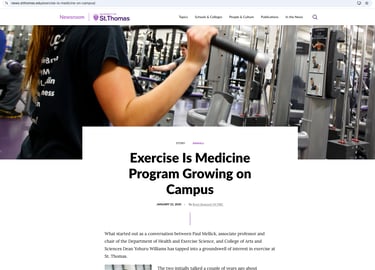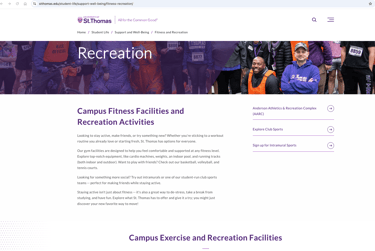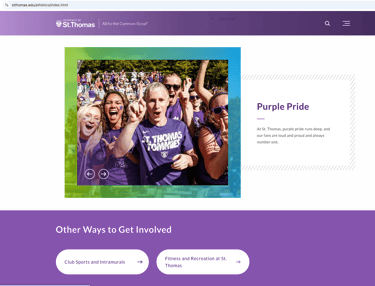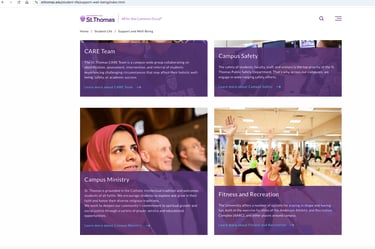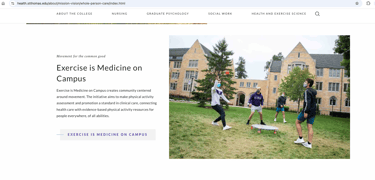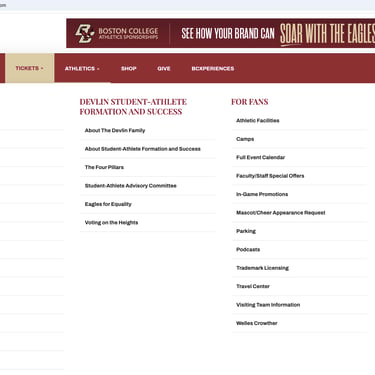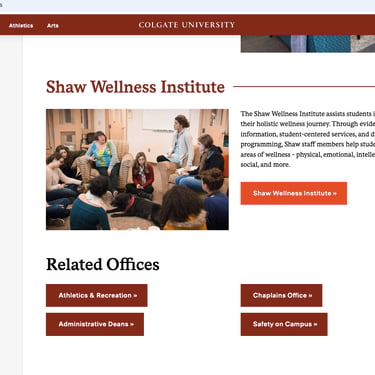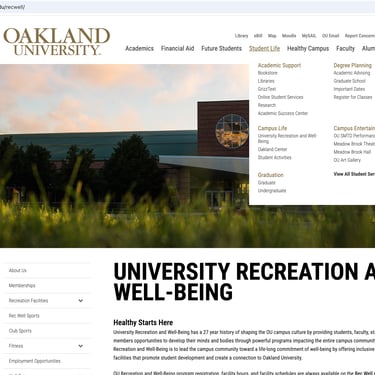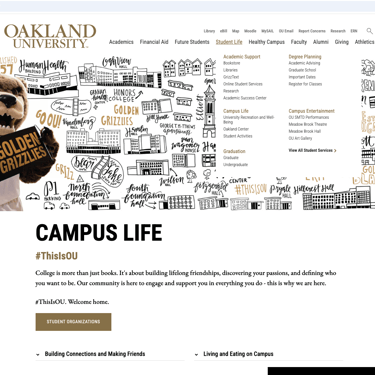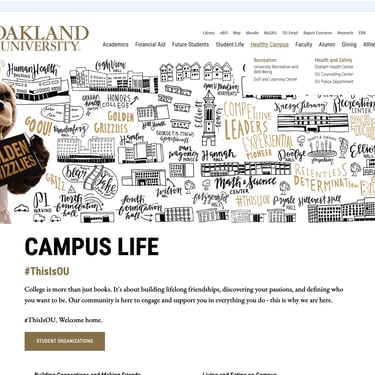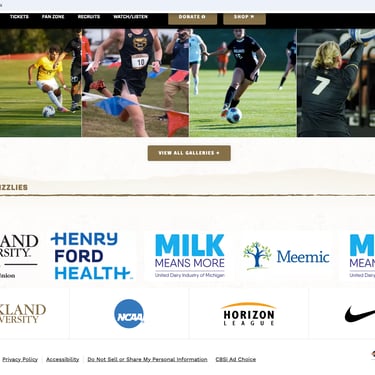Rec in Athletics - Part Two
Reviewing how athletic departments and universities promote and place their collegiate recreation programs.
WEBSITE RANKINGS
9/15/20255 min read
I seem to have hit on something when analyzing how universities support student wellbeing. In this case, it was about how varsity athletic programs who oversee recreation represent the department on their website. So, I am going to go down a little journey and share examples - good and not-so-good - from different universities. And to be clear, I don’t have any more context than what I see on these websites, and there is no finger pointing. But I do believe firmly that movement (exercise, sports, adventure, etc) is the best return for helping today’s students and I think it’s important that it gets recognized as such…today we look at DIII St. Thomas in Minneapolis, Horizon League member Oakland University, and revisit Colgate for a deeper dive.
Fourth Up - St. Thomas (Minneapolis)
On the one hand the university's home page does a great job in their drop down including club sports and intramurals in the same frame as an external link to varsity Athletics (the Tommies!). One thing I can't figure out is if you can get back to the main university web-site from the Athletic Department site. Turns out you can - but only at the very bottom of the pages and then it only takes you to Admissions.
It's an interesting approach - they list the two sports-based parts of recreation, Club Sports and Intramurals, under Athletics. But then Fitness and Recreation is listed under Student Life at the bottom of the support and well-being section.
As a DIII university it is certainly a different approach then a DI school - I did find this in their Fitness and Recreation "All students, faculty, and staff are welcome to use the AARC's fitness facilities, indoor track, courts, and training equipment during open recreation hours, which are scheduled around varsity athletic practices and events." So in a resource priority, it appears that varsity athletes take precedence. I find that a bit disheartening when the total percentage of athletes to overall students is no more than 10%
While the main website for the university does a nice job of being inclusive for sports and recreation, I’d still like to see the recreation piece being a bit more prioritized as it relates to student life and not have it be buried under Support and Well-Being.
I was excited to find a link to a campaign on Exercise as Medicine - I thought that maybe I was being a bit unfair - but unfortunately the link went to a piece that was written in early 2020 and I was unable to find any other reference to that great program.
Overall, the website does a nice job trying to show some balance between the varsity side and the rec side, though the clear focus on sports is a missed opportunity to engage other types of recreation. Located in such a beautiful location, it would be great to see a connection to outdoor recreation as well as more focus on the connection between exercise, wellbeing, and academic success. Finally, does a wonderful job consistently referring back to their Jesuit values and in some ways I appreciate their staying focused on their mission.
School Five: Oakland University
I've followed Oakland University ever since I got involved in NIRSA. They have produced a ton of super leaders and so I thought I would give them a look as a potential standard-bearer. And there is a lot to like about how much the University supports recreation, and it also appears that organizationally there is a bit of a disconnect on reporting structures and priorities.
Oakland University does something that I think it pretty unique and super-supportive of their recreation department.
They have a great name in University Recreation and Well-being and they pop up twice on the home page, once under Student Life and once under Healthy Campus. That speaks a lot to how important recreation is to the university. I have not seen this happen at other schools (yet) but it is exactly the story that I think should be told. Recreation covers movement and health, and helping students find their path through both interests is really helpful.
Yet, at Oakland Recreation and Well-being reports to Athletics, at least according to the Org Charts I can find online. On the Athletics website there is no mention of Recreation at all. In some ways that is clean and defining. In others, a lost opportunity to build community.
Here is an interesting observation about SideArm sports sites like the one Oakland uses -- the link back to the main university is positioned as a sponsor of the program, rather than the reason for there even being an athletic department. There is a link back to the main campus web-site, but it's treated like a business sponsor instead of the mother-ship; the main university gets the same treatment as their other corporate sponsors - they get treated equally to their Milk sponsorship. It seems like it should be the other way around, but this is certainly a pattern that is emerging. It's an interesting approach and maybe one that is indicative of the role that varsity athletics plays. Personally, I think it should somehow have a stronger link directly back to the University -- as we get into this House settlement more, how this plays out will be a good thing to follow.
School Three: Colgate
I had checked my work on Colgate in the previous post, and I wanted to come back and give them a bit more credit. In the Patriot League, Colgate' home page has Athletics & Recreation listed together under Student Life. That is awesome.
Then, when you open that Student Life page, again you see that they jointly promote varsity and recreation - the text is balanced and they really do a great job linking the two programs "Colgate is home to 25 NCAA Division I athletic teams and numerous club and intramural sports programs. While Colgate students cheer for the Raiders, they also advance their physical wellness through a wide variety of fitness and recreational activities. Learn more about Colgate athletics, recreational sports and facilities, physical education program, outdoor education, and more." It's a great example!
The university’s section on Student Life seems to do a really nice job trying to balance Athletics and Recreation as you can see below. I’m only showing the top of the page, but lower down they have club sports and intramurals and outdoor. I’d rather see a direct link to the overall recreation department than the focus on the fitness programming (particularly with Colgate’s beautiful location and the nearby outdoors), but this feels like a pretty nice representation. It is nice and clean, easy to navigate and understand, and gets you where you need to go. I’d still advocate that PE and Recreation should be in the top header so that it appears just as important as Student-Athletes or individual sports. But it’s not bad.
The colgateathletics website also does a really nice job recognizing that PE and Recreation are part of the department. As you can see in the pictures, they give it it's own section under "Inside Athletics".
My one little change I'd like to see is having recreation seen as a more active partner in the health and wellness information. You can see that they are listed as a Related Office, but I'd really like to see them really go all in on that. Recreation can be both - health and wellness and part of sports, they do not have to be bifurcated so much.
Overall Colgate is winning the day so far - many more schools to look through, but this is a great example of a varsity department and sharing the limelight with their recreational sports colleagues.
That's five schools down, only hundreds to go! I’ve got a list growing of all the schools that have Recreation reporting up through Athletics. Over time I’ll try to get to them all (?).
Let me know if you’ve got a school you’d like a quick review of or if you’ve got feedback.
My intent is to try and elevate the importance of movement for college students, faculty, and staff. I want people to be on the fields themselves and not always watching. I want to encourage universities and colleges to elevate movement as a solution to the belonging and loneliness, and mental and physical health issues, they are trying to solve. By working through organizational structures and story-telling we can change the narrative.

